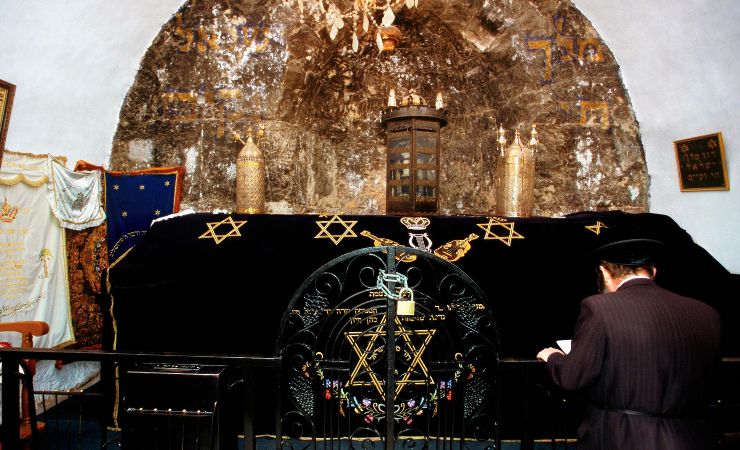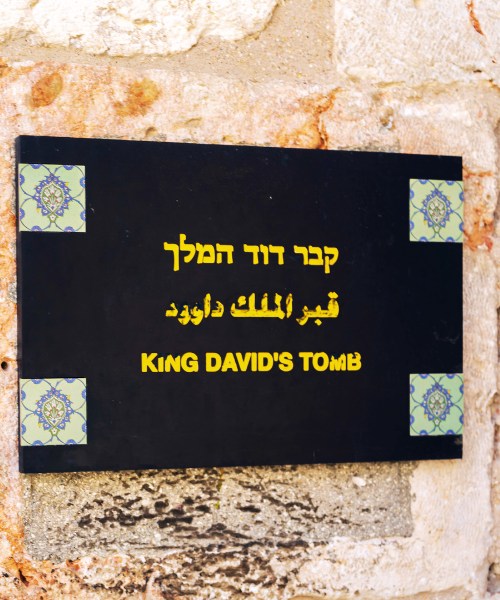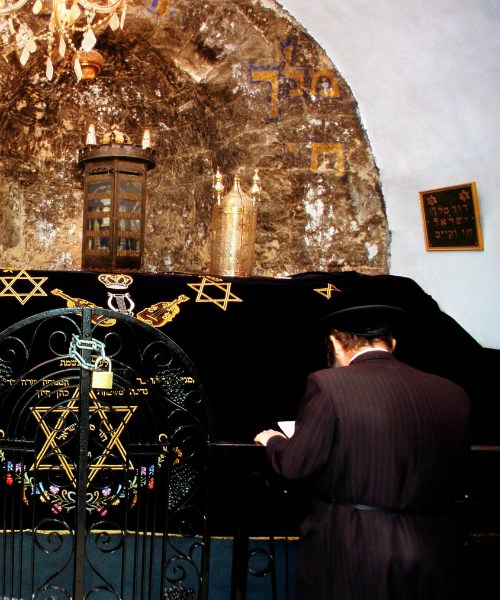King David's Tomb: The Burial Site of the Mighty King of Israel
King David’s Tomb is traditionally located on Mount Zion in Jerusalem, in a building complex that also houses the Cenacle, the site of the Last Supper. The tomb is situated in a ground floor room of the complex, marked by a large cenotaph adorned with a velvet cloth and embroidered with symbols associated with King David, including a crown and a harp.
The exact location and authenticity of the tomb have been subjects of debate among historians, archaeologists, and religious scholars.

Location
The traditional site of King David’s Tomb is located on Mount Zion, just outside the Old City walls of Jerusalem, near the Zion Gate. It sits at the ground level of a complex that also includes what is traditionally identified as the Room of the Last Supper (Cenacle) on the upper floor.
Biblical Context
Then David rested with his ancestors and was buried in the City of David.
The identification of King David’s Tomb with its current location on Mount Zion dates back to the Byzantine period, around the 4th century CE. However, it’s important to note that this identification was based more on religious tradition and pilgrimage practices than on archaeological evidence.
The historical context of the tomb’s identification is further complicated by the fact that the area known today as Mount Zion was not part of inhabited Jerusalem during King David’s time. This has led some scholars to argue that the tomb’s location on Mount Zion is highly improbable, if not impossible.
The identification of King David’s Tomb on Mount Zion was further solidified by the accounts of various pilgrims and travelers throughout the Middle Ages. These accounts, while not providing definitive archaeological evidence, have contributed to the enduring belief in the tomb’s location on Mount Zion.
Historical Conflicts Surrounding King David's Tomb
The site traditionally identified as King David’s Tomb has been a subject of contention and conflict throughout history, reflecting the complex and layered history of Jerusalem itself. The disputes surrounding the site often mirror the broader religious and political conflicts that have characterized the region over the centuries.
The earliest conflicts over the site can be traced back to the question of its authenticity. According to some scholars, the area known today as Mount Zion was not part of inhabited Jerusalem in King David’s time, making it highly improbable that he was buried there. This view is supported by the Bible, which states that David was buried in the City of David (1 Kings 2:10), a location that most scholars agree is not the same as the current Mount Zion. Others believe differently. Despite this, the tradition of King David’s Tomb being located on Mount Zion has persisted.
The site has also been a focal point of conflict between different religious communities. Over the centuries, the Tomb has been under the control of various religious groups, including Christians, Muslims, and Jews, each of whom has left their mark on the site. These shifts in control often reflected the broader political changes in the region, with each new ruling power imposing its own religious and cultural practices on the site.



Archaeology and Architecture of the Tomb
The current structure housing King David’s Tomb is a mixture of architectural styles reflecting the various periods of its construction and renovation. The building complex includes elements of Romanesque, Gothic, and Ottoman architecture.
Inside the ground-floor tomb room, you’ll see a large stone structure called a cenotaph. It’s not the actual burial site, but a marker that symbolizes the tomb. The current cenotaph, designed in Gothic style, is believed to date back to the time of the Crusaders. Since 1949, it has been covered with a blue cloth decorated with simple designs, including a crown, Torah scrolls, a violin, and Hebrew writing.
Because of the religious importance of the site and sensitivities among different faiths, archaeological digs around the tomb compound on Mount Zion have been limited. One of the earliest known descriptions comes from Ermete Pierotti, an Italian engineer and architect who visited in 1859. He claimed to have discovered a cave beneath the cemetery on Mount Zion’s western slope, which he believed was the real burial site of King David, carved directly into the rock.
In 1951, archaeologist Jacob Pinkerfeld carried out a short excavation. He focused on the lower sections of the building and suggested that it may have originally been a synagogue, later reused by early Jewish followers of Jesus. He pointed to a niche in the structure’s original wall that faces the Temple Mount, proposing it once held a Torah ark. However, not all scholars agree with him—some believe the building may have been a church or a synagogue used by Judeo-Christians.
More recently, Dr. Gabi Barkai carried out limited excavations beneath the cenotaph (the symbolic tomb) and reportedly uncovered a staircase leading to a burial cave dating back to the First Temple period. Barkai doesn’t believe this was King David’s tomb—he places that in the City of David—but he suggests the cave may have been used to bury later Judean kings. One theory is that it could be linked to kings like Menashe, who may have been buried outside the main royal tombs because of their controversial reigns. The Bible mentions a burial place called “Gan Uzzah” for some of these kings, and it might be in the general area of Mount Zion, especially after Jerusalem expanded during that time.
The Vandalism of Ottoman Mosaics
A significant incident in the recent history of King David’s Tomb involves the destruction of Ottoman-era ceramic tiles that once adorned the walls of the tomb’s main room. These tiles, dating back to the 17th century, were shattered in 2012 by a 30-year-old man who was later arrested. The man, who had come to the tomb to pray for a marriage match, was informed that his prayers would only be answered if he prayed directly to the stones behind the ceramic tiles.
Approximately two weeks later, vandals further destroyed the antique ceramic tiles, which were created by Ottoman-era artists and served as a testament to the tomb’s multicultural history. This act of vandalism was met with protest from a group of academics and historians, who argued that the Israel Antiquities Authority’s (IAA) decision not to restore the tiles was tantamount to rewarding the vandals.
The IAA defended its decision, stating that the tiles were irreversibly damaged and that a full restoration would not be in line with the authority’s mission. Instead, the IAA chose to preserve the hewn rock walls of the original structure. The few tiles that survived the vandalism were left in place and professionally preserved.
Additional Information
Biblical Period (Approx. 10th Century BCE)
- Approx. 1000 BCE: King David conquers the Jebusite fortress called the “stronghold of Zion,” which becomes his palace and the City of David.
- Approx. 965 BCE: King David dies and is buried in the City of David (according to the Bible).
- First Temple Period (approx. 960 BCE – 586 BCE): Most of the Judean kings of the House of David are buried “with their fathers” in the City of David.
- Late First Temple Period: The city of Jerusalem expands westward, and the western hill comes to be known as Mount Zion.
Second Temple Period (Approx. 516 BCE – 70 CE)
- Post-Exile (after 539 BCE): The tombs of the House of David are still known and mentioned as a landmark in Jerusalem in the Book of Nehemiah.
- Around 2nd Century BCE: The first book of Maccabees mentions Mount Zion.
- First Century CE: The Apostle Peter refers to the location of David’s tomb as commonly known in his sermon on the day of Pentecost.
Roman Period (Approx. 1st – 4th Centuries CE)
- Circa 2nd Century CE: Jacob Pinkerfeld proposes that the lower part of the current David’s Tomb structure was originally a 2nd-century, late-Roman synagogue.
Byzantine Period (Approx. 4th – 7th Centuries CE)
- 4th Century CE: The Pilgrim of Bordeaux reports finding David buried in Bethlehem.
- Antiquity: The house with the Upper Room is known as “Holy Zion, Mother of Churches.”
Early Islamic Period (Approx. 7th – 10th Centuries CE)
- No earlier than 10th Century CE: Muslims begin to venerate David’s tomb on Mount Zion, possibly following Christian and Jewish leads.
Crusader and Mamluk Periods (Approx. 11th – 16th Centuries CE)
- 12th Century: Jewish pilgrim Benjamin of Tudela recounts a tale of workmen discovering David’s tomb on Mount Zion, incorporating details from Josephus.
- 1230: The Franciscan Order is established in Jerusalem with their headquarters in the Cenacle on Mount Zion.
- 1332: The Franciscans obtain the Cenacle from the Egyptian Sultan, Melek-el-Nasr.
- 1429: Mamluk Sultan Barsbay takes part of the lower floor of the complex from the Franciscans and converts the tomb chamber into a mosque.
- 1430: Possession of the tomb chamber alternates between Muslims and Franciscans.
- 1452: The tomb of David is handed over to the Muslims by the Franciscan monks.
Ottoman Period (Approx. 16th – 20th Centuries CE)
- 1523: Muslim authorities expel the Franciscans from the entire building (including the Cenacle and the tomb).
- 1524: The “chapel of the Holy Spirit” (the Cenacle) is transformed into a mosque, as evidenced by an inscription.
- 1536–41: Suleiman the Magnificent rebuilds Jerusalem’s walls, leaving Mount Zion outside the city.
- 1548: Ottoman Sultan decides the entire mountain is Muslim sacred property, transferring the site to the management of Sheikh al-Dajani. The structure is turned into a mosque and a minaret is added.
- 17th Century: Ottoman-era ceramic tiles are added to the walls of the tomb chamber.
- 1913: French-Jewish scholar Raymond Weill begins excavations in the City of David, seeking the royal tombs. He finds eight structures (T1-T8) he interprets as tombs.
British Mandate Period (1920-1948)
- The site is considered “absolutely under the authority of the Moslem Waqf of Nebi Daud,” who arrange access for visitors of all faiths. Christians are permitted to enter the Cenaculum but not to pray, and Jews are allowed to pray once a year if the political situation allows.
- 1923-1924: Raymond Weill conducts a second excavation, uncovering a ninth tomb (T9).
Israeli Control and Recent Events (1948 – Present)
- 1948: After the Arab-Israeli War, the southern part of Mount Zion, including the Tomb, is on the Israeli side of the Green Line.
- 1948-1967: With the eastern part of the Old City occupied by Jordan and inaccessible to Jews, Jewish pilgrims visit David’s Tomb on Mount Zion and pray from the rooftop overlooking the Western Wall. The Diaspora Yeshiva Jewish seminary group begins administering the building.
- 1951: Archaeologist Jacob Pinkerfeld works in the lower parts of the structure and interprets them as the remains of a synagogue later used by Judeo-Christians.
- 1967: The Six-Day War results in the reclamation of Jewish holy places in the Old City, leading to a decline in the status of David’s Tomb as the primary Jewish pilgrimage site.
- 2000: Pope John Paul II conducts a mass in the Coenaculum during his visit to Israel.
- 2008: A statue of King David, gifted by the Russian Charitable Foundation of St. Nicholas the Wonderworker, is installed near the David’s Tomb compound. It is negatively received by some ultra-Orthodox Jewish community members.
- 2009: Pope Benedict XVI visits the Coenaculum.
- December 2012: A 30-year-old ultra-Orthodox man is caught smashing 17th-century Islamic tiles in the tomb chamber, stating he did it to help him find a wife. The damage is described as total. More ceramic tiles at the site are vandalized in 2013.
- 2018: The statue of King David on Mount Zion is dismantled after being vandalized multiple times.
Sites Nearby
- Dormition Abbey: This massive basilica, located on Mount Zion, commemorates the “falling asleep” (death) of the Virgin Mary.
- Zion Gate: One of the eight gates in the walls of the Old City of Jerusalem, Zion Gate leads directly into the Armenian and Jewish Quarters.
- The Jewish Quarter: This is one of the four traditional quarters of the Old City of Jerusalem. It is home to several important sites, including the Broad Wall, the Hurva Synagogue, the Roman Cardo, and the Western Wall.
- Cenacle (The Room of the Last Supper): Located in the same building complex as King David’s Tomb, the Cenacle is traditionally believed to be the site of the Last Supper.



